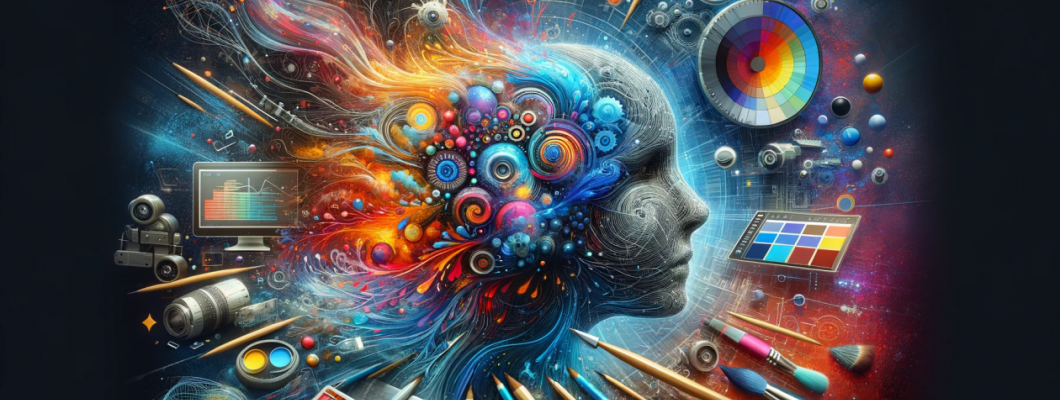
Graphic design is a powerful and versatile discipline that blends creativity, technology, and communication. It’s an essential part of our daily lives, influencing how we perceive information and interact with brands, products, and ideas. From the logos we see on products to the user interfaces we navigate on websites, graphic design plays a critical role in shaping our experiences.
Graphic design is a dynamic and multifaceted discipline that touches nearly every aspect of modern life. Its history is rich with innovation, from the earliest forms of visual communication to today’s cutting-edge digital designs. The principles of balance, contrast, alignment, and hierarchy guide designers in creating effective visual communication, while color, typography, and space add depth and personality to a design.
Key Principles of Graphic Design
Graphic design is built upon a set of core principles that guide designers in creating effective and aesthetically pleasing visual communication. These principles ensure that the design is not only visually attractive but also functional and easy to understand. The key principles include:
- Balance: Balance in design refers to the distribution of visual weight within a composition. It can be symmetrical, asymmetrical, or radial. Symmetrical balance provides a sense of stability, while asymmetrical balance creates a more dynamic and engaging layout.
- Contrast: Contrast is essential for making certain elements stand out and ensuring legibility. It can be achieved through differences in color, size, shape, or texture. A strong contrast between text and background improves readability, while contrasting elements in a layout help to direct the viewer’s attention.
- Alignment: Alignment refers to the arrangement of elements along a common axis or line. Proper alignment creates order, organization, and a sense of unity in the design. It ensures that different elements relate to each other and work together harmoniously.
- Repetition: Repetition reinforces consistency and coherence in design. By repeating visual elements such as colors, fonts, or shapes, a designer can create a sense of rhythm and unity within the composition. It also helps in establishing brand identity by maintaining a consistent visual style.
- Proximity: Proximity refers to how closely or far apart elements are placed in a design. Elements that are related to each other should be grouped together, while unrelated elements should be spaced apart. This helps in organizing information and improving the viewer's understanding of the content.
- Hierarchy: Visual hierarchy is the arrangement of elements to guide the viewer’s eye through the design. It ensures that the most important information is emphasized and easily seen. Designers use size, contrast, color, and positioning to create a hierarchy that directs attention to key elements.
- Space: Also known as negative space or white space, space is the area around and between elements in a design. Effective use of space can enhance readability, highlight important elements, and create a more balanced composition.
- Typography: Typography refers to the selection and arrangement of typefaces to create readable, legible, and visually appealing text. Good typography involves choosing the right font, size, spacing, and alignment to convey the message clearly.
The Role of Color in Graphic Design
Color is one of the most powerful tools in a designer's arsenal. It evokes emotions, communicates meaning, and influences how a design is perceived. Different colors have different psychological effects, and understanding color theory is essential for creating impactful designs.
- Red is associated with passion, energy, and urgency. It’s often used in marketing to grab attention or convey a sense of excitement.
- Blue is calming and trustworthy, often used by corporate brands to evoke professionalism and reliability.
- Yellow is cheerful and optimistic, commonly used to attract attention in a positive way.
- Green is associated with nature, growth, and health, making it a popular choice for eco-friendly or wellness brands.
- Black conveys sophistication, elegance, and authority. It’s often used in luxury branding.
Tools and Software in Graphic Design
Graphic design has evolved significantly with the advent of digital tools. Today, designers have access to a wide range of software that allows them to create both print and digital designs. Some of the most commonly used tools in the field include
- Adobe Photoshop: Photoshop is one of the most widely used graphic design tools, primarily for editing and manipulating images. It allows designers to create everything from simple logos to complex digital artwork.
- Adobe Illustrator: Illustrator is a vector-based design tool used for creating logos, icons, typography, and illustrations. Unlike Photoshop, which works with pixels, Illustrator works with vectors, allowing for infinite scalability without loss of quality.
- Adobe InDesign: In Design is a layout design tool used for creating print materials such as brochures, magazines, books, and posters. It allows designers to arrange text and images in complex layouts.
- Sketch: Sketch is a popular tool for digital and UI/UX design. It’s widely used for creating wireframes, prototypes, and interfaces for websites and mobile applications.
- Canva: Canva is a user-friendly, web-based design tool that allows non-professionals to create simple designs. It’s particularly popular for social media graphics, presentations, and infographics.
- Figma: Figma is a cloud-based design tool that allows for real-time collaboration. It’s popular among UI/UX designers for creating prototypes and interfaces.
- CorelDRAW: CorelDRAW is a vector graphic editor similar to Illustrator, used for creating illustrations, logos, and other types of graphic design.
The Evolving Trends in Graphic Design
Graphic design is constantly evolving, influenced by changes in technology, culture, and aesthetics. Staying up-to-date with current trends is crucial for designers who want to create relevant and impactful designs. Some of the major trends in graphic design today include:
- Minimalism: Minimalist design has been popular for several years, focusing on simplicity and functionality. This trend often uses clean lines, monochromatic color schemes, and ample white space to create elegant and uncluttered designs.
- 3D Design and Typography: The rise of 3D design tools has allowed designers to create more immersive and realistic visuals. 3D typography, in particular, has become a popular way to add depth and dimension to a design.
- Bold Colors and Gradients: Bold, vibrant colors and gradients are making a comeback in graphic design, especially in digital media. These eye-catching color schemes help designs stand out in a crowded visual landscape.
- Custom Illustrations: Brands are increasingly using custom illustrations to create a unique and personalized visual identity. Hand-drawn elements add warmth and character to a design, making it more memorable.
Sustainability and Eco-Friendly Design: As environmental awareness grows, many designers are focusing on sustainability in both their design processes and the materials they use. This includes using eco-friendly printing methods and creating designs that promote sustainability.
- Data Visualization and Infographics: With the rise of big data, designers are increasingly tasked with creating visually appealing and easy-to-understand data visualizations. Infographics are a popular way to present complex information in a visually engaging way.
- Augmented Reality (AR) and Virtual Reality (VR): AR and VR are opening up new possibilities for interactive and immersive design experiences. Designers are beginning to experiment with how these technologies can enhance storytelling and brand experiences.
The Importance of Graphic Design in Contemporary Society:
In today’s fast-paced, visually driven world, graphic design plays a crucial role in how we communicate and consume information. It’s an essential tool for businesses, organizations, and individuals who want to stand out in a crowded marketplace. Good graphic design has the power to
- Effective Communication: Graphic design enhances communication by using visual elements to convey ideas, messages, and emotions. Complex information is often made easier to understand through visuals such as infographics, charts, and diagrams. By combining images, typography, and colors, graphic design creates a more engaging and digestible presentation of information.
- Brand Identity and Recognition: Graphic design is essential in establishing and maintaining a brand’s identity. A consistent visual identity, including logos, color schemes, typography, and imagery, helps create a strong and recognizable brand. This visual consistency across various platforms (websites, packaging, social media, advertisements) builds trust and makes a brand memorable.
- Building Trust and Credibility: Good design fosters professionalism and trust. A well-designed website, brochure, or business card signals to potential clients and customers that the brand or organization is serious and reliable. On the other hand, poor design can give the impression of low quality, lack of attention to detail, or even untrustworthiness.
- First Impressions: In many cases, a brand’s first interaction with its audience is through visual elements such as websites, social media graphics, or advertisements. A strong and appealing design can capture attention quickly and leave a lasting positive impression. This first impression often influences a person’s perception of a brand or product and can determine whether they choose to engage further.
- Enhancing User Experience (UX): In the digital world, graphic design plays a crucial role in user experience (UX). Well-designed websites and apps are easy to navigate, intuitive, and visually appealing. Effective UX design ensures that users can find the information they need and complete tasks without frustration, which enhances their overall satisfaction with the product or service.
- Boosting Conversions and Sales: Graphic design is a powerful tool for influencing consumer behavior. Well-crafted designs in marketing materials, advertisements, and product packaging can evoke emotions, create urgency, and prompt a purchase. The design of promotional content, call-to-action buttons, and landing pages can significantly impact conversion rates and sales.
- Social Media and Online Presence: Social media platforms are highly visual, and graphic design is key to standing out in crowded newsfeeds. Attention-grabbing visuals, cohesive branding, and aesthetically pleasing content can significantly increase engagement rates, shares, and likes. Graphics help convey information quickly and effectively, whether it’s through memes, infographics, or video content.
- Supports Marketing and Advertising: In marketing and advertising, graphic design is the cornerstone of creating compelling campaigns that resonate with target audiences. From digital ads and billboards to email newsletters and product packaging, the design sets the tone and conveys the intended message. Good design not only captures attention but also communicates value propositions and calls to action effectively.
- Facilitates Better Learning: Graphic design plays an important role in education and knowledge sharing. By combining text with visuals such as illustrations, infographics, and diagrams, graphic design can make complex concepts easier to understand. In e-learning, textbooks, or presentations, well-designed materials enhance the learning experience and retention of information
- A Competitive Advantage: In highly competitive markets, having high-quality graphic design gives a brand or product a distinct edge. Consumers are drawn to visually appealing designs, and a polished, professional aesthetic can set one brand apart from others. Whether it’s through product packaging, advertising, or web design, investing in strong graphic design can lead to increased visibility and brand loyalty.
Our Graphic Design Expertise: At VCD Studio, we pride ourselves on our extensive expertise in graphic design. Our team of skilled designers stays up-to-date with the latest trends and technologies to deliver high-quality, innovative designs.
Conclusion:
Graphic design is an essential aspect of modern communication, shaping how we perceive and interact with the world around us. It is a powerful tool for businesses, individuals, and organizations to communicate messages, create emotional connections, and influence behavior. From building a strong brand identity to enhancing user experience and driving conversions, graphic design’s importance cannot be overstated. Whether in print or digital media, effective design enhances visibility, fosters trust, and ultimately supports business growth and social impact.


Leave a Comment